Was Brunelleschi Easy to Get Along With
Filippo Brunelleschi was a pivotal innovator of Italian Renaissance architecture. Brunelleschi's architecture merged the study of arithmetic and geometry, both ancient and more current architectural and design ideas, as well as engineering and construction, making him one of the most original inventors of his time in a multitude of disciplines. Filippo Brunelleschi's artwork was renowned for its display of the artist's greatest achievement: the development of the linear perspective technique for depicting a three-dimensional environment. The representational approach utilized in Filippo Brunelleschi's paintings rapidly became the dominant style of depiction in European art till the current day.
Table of Contents
- 1 Filippo Brunelleschi's Biography
- 1.1 Childhood
- 1.2 Education and Early Training
- 1.3 Mature Period
- 1.4 Late Period and Death
- 2 Legacy and Accomplishments of Filippo Brunelleschi
- 2.1 Legacy
- 2.2 Accomplishments
- 3 Filippo Brunelleschi's Most Important Works
- 4 Recommended Reading
- 4.1 Filippo Brunelleschi (2002) by Eugenio Battisti
- 4.2 Brunelleschi: Studies of His Technology and Inventions (2004) by Frank Prager
- 5 Frequently Asked Questions
- 5.1 Why Is Filippo Brunelleschi's Artwork Important?
- 5.2 What Defined Brunelleschi's Architecture?
Filippo Brunelleschi's Biography
| Nationality | Italian |
| Date of Birth | c. 1377 |
| Date of Death | 15 April 1446 |
| Place of Birth | Florence |
Brunelleschi's architecture drew on his intense knowledge of the preceding generation's Romanesque edifices as well as a reemergence of classical Greco-Roman structures to create an aesthetic predicated on geometric fundamentals and proportional systems that would come to characterize Renaissance architecture.
His creation of a dome for the famous cathedral in Florence, a task that had gone unresolved for a hundred years, garnered him considerable acclaim during his career and remains his most notable work. From his era forward, the engineering procedures he devised for the dome were revered and analyzed, and they remained unrivaled until the 20th century.
Childhood
Filippo Brunelleschi was the son of a wealthy Florentine family. The fact that he originated from a wealthy family helped him navigate the bureaucratic complexities of his subsequent creative career. His father was a solicitor and public official, and Giuliana, his mother, was from the affluent Spini dynasty. His two siblings, one of whom became a jeweler and the other a cleric, inspired him. There isn't much else documented about his childhood.
Brunelleschi was educated in arithmetic and language in order to enter a legal profession like his father.
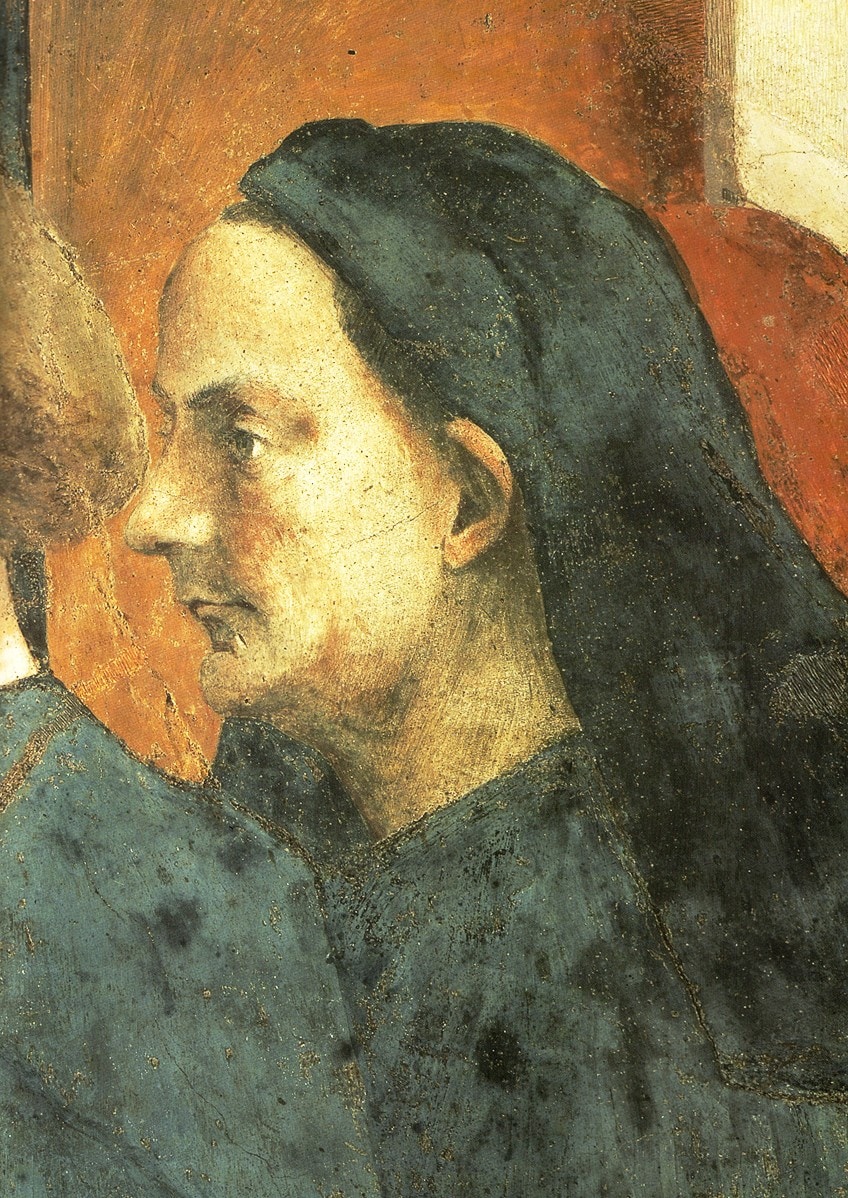 Painting of architect Filippo Brunelleschi (c. 1423 and 1428); see filename or category, Public domain, via Wikimedia Commons
Painting of architect Filippo Brunelleschi (c. 1423 and 1428); see filename or category, Public domain, via Wikimedia Commons
Education and Early Training
Brunelleschi worked as a goldsmith trainee in a family friend's studio from the age of 14 to roughly 18. He would have studied several methods there, from attaching precious stones to etching and molding metal to making more complicated structures such as altars and holy objects, and he would have also acquired an aptitude in mechanical systems through constructing timepieces.
At the age of 21, he finished his apprenticeship and then became a master goldsmith in 1398. His first known works were a series of miniature silver sculptures of preachers and saints made between 1399 and 1401.
These were his contributions to the communal effort to build the Cathedral of Saint Zeno's massive Saint James altar, midway between Pisa and Florence, where Filippo Brunelleschi had traveled to avoid an outburst of the plague that ravaged Florence on a routine basis. Following a particularly devastating epidemic in 1400, the affluent wool merchant's guild in Florence – which supported the upkeep and decorating of the Baptistery in which every newborn in Florence was christened – organized a design contest in 1401 for a new pair of carved and plated bronze doors.
It was a huge chance for an individual to develop his career, and seven contenders submitted their ideas, which included Brunelleschi as well as Lorenzo Ghiberti, a youthful sculptor who would grow to be Brunelleschi's adversary. Entries had to be in the shape of a single bronze panel showing the scriptures of the Sacrifice of Isaac, and they were to compliment the pre-existing doors, which Andrea Pisano constructed in 1330.
There are two contradicting descriptions of the competition's result. Ghiberti and Brunelleschi were undoubtedly the two top competitors.
According to Brunelleschi's biographer and possibly friend, Antonio di Tuccio Manetti, the judges eventually proclaimed a tie between Brunelleschi's spectacular layout and Ghiberti's simplified, more attractive designs, and it was proposed that the creators collaborate to finish the 28 panels for the Baptistery door job. Brunelleschi, on the other hand, demanded that he be given the entire project, and when the jurors disagreed, he quit, establishing Ghiberti as the champion.
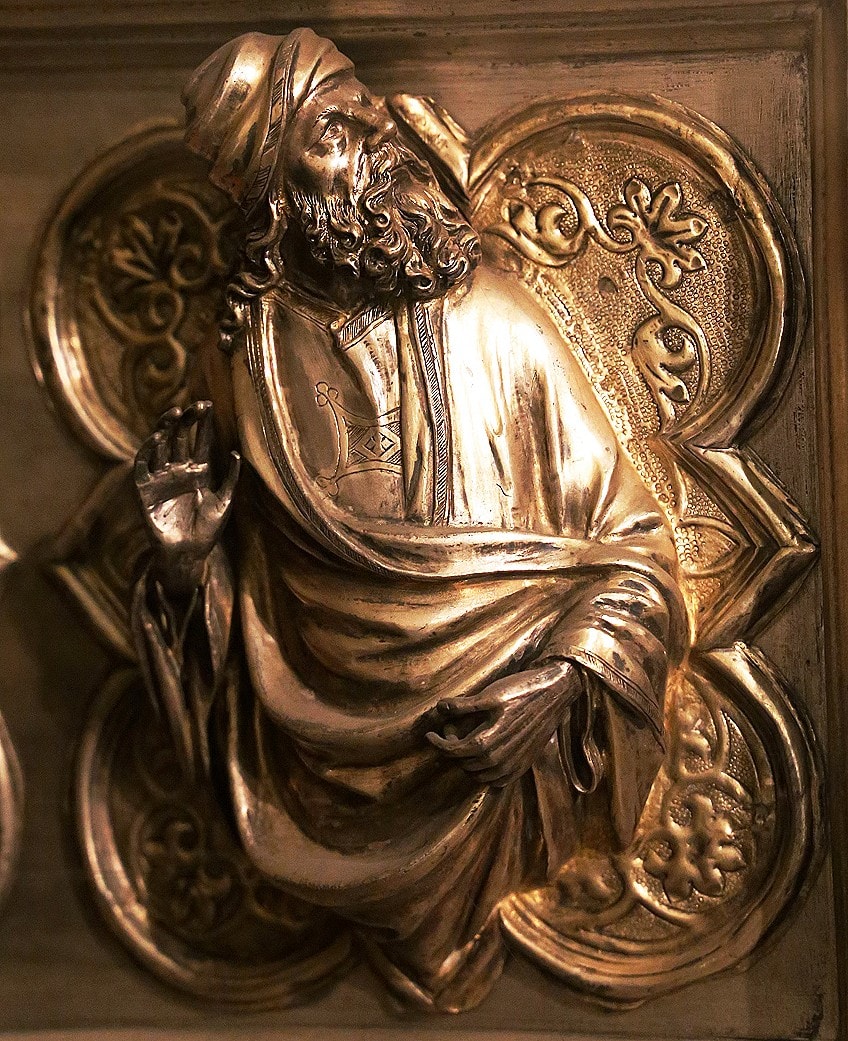 TheProphet Isaiah (1399 – 1400), located in the Church of San Zeno. Pistoia detail of altarpiece; Sailko, CC BY 3.0, via Wikimedia Commons
TheProphet Isaiah (1399 – 1400), located in the Church of San Zeno. Pistoia detail of altarpiece; Sailko, CC BY 3.0, via Wikimedia Commons
The opposite narrative is in Ghiberti's memoirs, which were written some 50 years after the incident, and in which he asserts that "All of the specialists and those who contested with me gave me the laurel of victory. After much debate and study by the specialists, it appeared to everyone that I had exceeded all of the rest." Historians have claimed that Ghiberti's vitriol in insisting on the decision's consensus may imply that the selection of his piece was not as clear-cut as he asserts.
Furthermore, the fact that both artists' works have survived while the other five have been lost lends credence to the notion that they were regarded as of comparable worth.
Filippo Brunelleschi's artwork undoubtedly struck the judges, especially his ability to communicate narrative tension through dramatic gestures and lively faces. He made an especially significant impression on the jury's chairman, financier Giovanni di Bicci de' Medici, who went on to become one of Brunelleschi's most prominent sponsors.
Nevertheless, the defeat was profoundly disheartening for Brunelleschi, and it was likely the reason he completed so few future sculptures. According to Manetti, the experience spurred the young artist to fly to Rome in search of a new path for his profession, escorted by the younger trainee artist Donatello. The journey formed a long-lasting friendship between the artists and, according to some researchers, a physical relationship, a sort of engagement that was very prevalent in Florentine culture.
There is no written record of Brunelleschi's presence in Rome, although such a voyage would have been appropriate for a Florentine artist engaged in the old Roman Republic's capital, the society that was also supposed to have built many of Florence's aesthetic monuments.
At that moment, Rome had a lesser population than Florence, and many of its historic ruins had been foraged for masonry or repurposed for pasturage. As a result, Brunelleschi and Donatello were among the first to attempt to rescue and study the city's old relics, initially focused on sculpture but later shifting their focus to buildings.
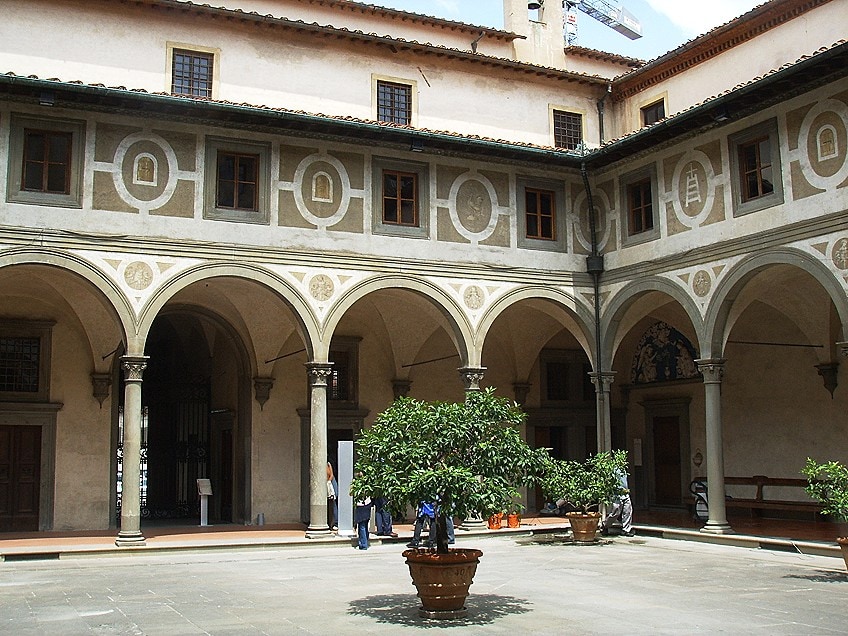 Cloister of Men of the Foundling Hospital (1419 – 1445); I, Sailko, CC BY-SA 3.0, via Wikimedia Commons
Cloister of Men of the Foundling Hospital (1419 – 1445); I, Sailko, CC BY-SA 3.0, via Wikimedia Commons
Brunelleschi, according to Manetti, measured and examined the wrecked structures to ascertain their height and dimensions, recording notes in cipher so that his observations could not be duplicated. Considering that Florence's still-under-construction cathedral had required a dome for many years, he must have been particularly fascinated with the Pantheon, the technique of building which was unknown. By mid-1404, Brunelleschi was again in Florence, at least for a brief time, and was nominated to a commission monitoring the erection of the cathedral, Santa Maria del Fiore, by guild members.
It was his first formal tie to the cathedral construction, and while working on the board, he must have had his recent research in Rome in memory. For the next 10 to 20 years, the historical narrative on Brunelleschi's activity is again scant. He appears to have split his time between Rome and Florence, and he may have traveled further, maybe to continue his architectural research.
Brunelleschi also started experimenting with trying to portray three-dimensional areas and items on two-dimensional surfaces during this period, revisiting the fundamentals of linear perspective, a methodical, arithmetical method to portrayal renowned to the ancient Greeks and Romans but overlooked or rebuffed in the intervening period. Brunelleschi's concern in precisely documenting architectural shapes and dimensions on the smaller size of a piece of paper is obviously tied to these ideas.
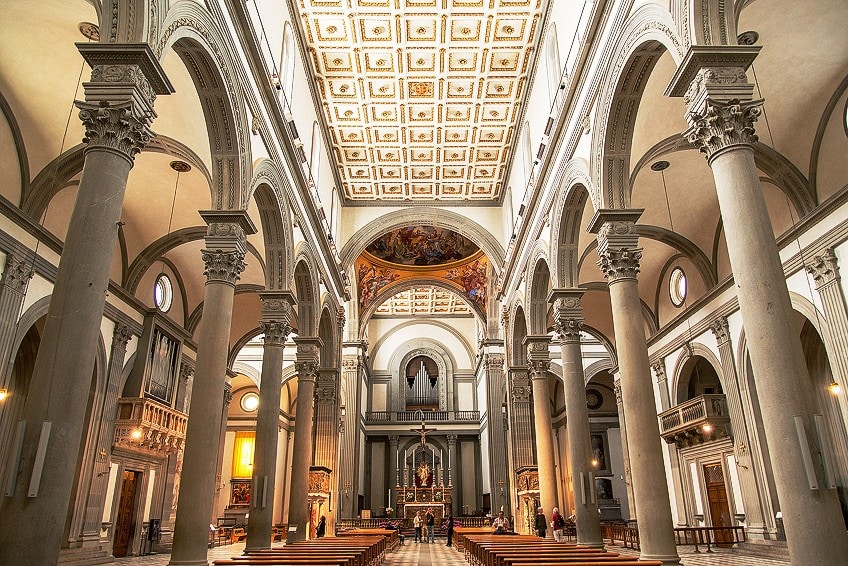 Nave of the Basilica of San Lorenzo (1425 – 1442);Peter K Burian, CC BY-SA 4.0, via Wikimedia Commons
Nave of the Basilica of San Lorenzo (1425 – 1442);Peter K Burian, CC BY-SA 4.0, via Wikimedia Commons
Brunelleschi painted two geometrically crafted images of the Florence Baptistery and the Piazza della Signoria, the first of which used a gadget wherein the spectator remained in one spot before the picture and glanced through a hole in the rear of the screen at a reflector that mirrored the picture on the front. As a result, the image the spectator saw was perfectly synced with the actual place and recreated its three-dimensional look. Brunelleschi did not record his revolutionary process for making these perspective representations, but he did share the ideas with his pupil Donatello, who integrated them into a low-relief sculptured scene by 1417.
The concepts of linear perspective were not written and extensively followed until Leon Battista Alberti, who met with Brunelleschi and other painters in Florence, wrote On Painting in 1435. Brunelleschi appears to have returned to Florence in 1409 when he counseled on projects such as the cathedral's continuing construction. However, he did not remain in the city completely until around 1416. He is documented as working on designs for the cathedral's great dome during the time, and he also adopted a son named Andrea after the place where he was born.
Brunelleschi never wed or had any other offspring, thus the boy became his only successor and proceeded in his father's creative footsteps, becoming an architect and sculptor who learned a great deal from both his father.
Mature Period
Brunelleschi started creating a wooden prototype based on his concept for the dome of Santa Maria del Fiore after settling more firmly in Florence, and by the time the contest for the erection of the dome was formally publicized in August 1418, he had already started construction on a bigger brick model. When the contest ended in December, just two of the 12 models entered were still being considered: Brunelleschi's and one built by his old adversary, Lorenzo Ghiberti.
Nevertheless, dome construction stalled for much of 1419, and Brunelleschi, maybe as a result of his newfound popularity in the cathedral project, garnered commissions for four other architectural projects, such as the Foundling Hospital, his very first community commission. The Silk Merchant's Guild, which included goldsmiths like Brunelleschi, was to fund and manage this structure. He actively worked on the structure until 1423 and was the authorized architect until 1427, though construction was not finished until around 1445.
Even so, Brunelleschi's layout, which showcased a façade with a long loggia of nine meticulously dimensioned arches supported by rows with traditional Corinthian capitals, was among the first to integrate Greco-Roman elements and constructing precepts into the modernist design, and it inspired countless successive Renaissance architecture structures. Finally, in 1420, the body in charge of the cathedral named both of the architects as directors of the dome project, even though the building followed Brunelleschi's plan and Ghiberti's participation was minor.
Despite his absence of architectural knowledge, Ghiberti's political talents and contacts within the guild may have contributed to this position. Brunelleschi's concept solved the century-old difficulty of erecting a gigantic dome for the cathedral without the need for temporary wooden scaffolding, known as centering, to bear the masonry as it was being erected.
 Vault of the Old Sacristy (Sagrestia vecchia), with the tomb of Giovanni di Bicci de' Medici; Sailko, CC BY 3.0, via Wikimedia Commons
Vault of the Old Sacristy (Sagrestia vecchia), with the tomb of Giovanni di Bicci de' Medici; Sailko, CC BY 3.0, via Wikimedia Commons
His layout, which constituted of an inner and outer dome with a stairway connecting them, used simple yet imaginative engineering to generate a self-supporting dome whose structure was unrivaled by anything constructed heretofore or for hundreds of years afterward, and which now stands in the heart of Florence as a monument to his cutting-edge genius. Brunelleschi also devised and constructed a new hoist to raise the large sandstone pillars and marble slabs necessary for the construction, which would have been impossible to move using current methods.
The hoist was powered by oxen and a set of gears that could be turned in either direction, allowing goods to be hoisted or lowered as the oxen walked in a single direction. Brunelleschi's idea was once again recognized as one of the great achievements of the time, and it was studied and drawn by succeeding architects, notably Leonardo da Vinci. Another innovation Brunelleschi created in association with the Santa Maria del Fiore dome was a big freight boat to convey heavy items, such as marble, that had to be carried into Florence.
As with all of his ideas, the architect did not want to discuss them freely for fear of someone stealing his concept, so he approached the city and was awarded one of the earliest patents for his boat, which became known as Il Badalona in June 1421.
The legal decree lauded Brunelleschi as "a person of the most perceptive intelligence, skill, and innovation," and barred anybody from developing or manufacturing any type of cargo ship for the following three years.
Sadly, when the boat was ultimately completed and laden with marble in 1428, it failed to make the journey from Pisa to Florence, and most of the cargo had to be unloaded along the way, and some may have been abandoned in the river, leaving Brunelleschi to bear the expenditures. In 1421, he began work on a project from Giovanni di Bicci de' Medici, on the old San Lorenzo Church, which was being expanded with additional an additional chapel.
Brunelleschi intended the chapel to be practically distinct from the cathedral of which it was a part, constructing it substantially by 1428 while the remainder of the basilica took several decades longer.
 Interior of Old Sacristy from the Basilica of San Lorenzo in Florence; Sailko, CC BY 3.0, via Wikimedia Commons
Interior of Old Sacristy from the Basilica of San Lorenzo in Florence; Sailko, CC BY 3.0, via Wikimedia Commons
The domed sacristy abided few established precepts, not least in its intent to be utilized as a burial place for the Medicis and an affirmation of their increasing aspirations; the sacristy was constructed in time to house Giovanni's tomb at its core on his death in 1429, a mark of Giovanni's urge to see his venture accomplished but also maybe because of his son Cosimo's increasing power.
Although the fundamental concept for the remainder of San Lorenzo had been established before Brunelleschi started construction, and its development was mostly funded by other patrons, Giovanni de' Medici is believed to have requested a fresh plan from the designer for the entire structure.
Although it is hard to say how much of the existing basilica was designed by Brunelleschi, the notions of routine, geometrically decided proportions, and architectural features derived from ancient Greece that he introduced in the sacristy – an aesthetic known as the antique manner – presumably influenced later work by innumerable other architects, even if Brunelleschi was not involved directly after 1429. Moreover, extending the church and the surrounding area necessitated the demolition of many existing buildings and streets to showcase the structure and boost the sponsors' prestige.
Brunelleschi undoubtedly absorbed and maybe contributed to this style of urban planning, and he used similar concepts in his later works. By the late 1420s, construction on the dome of Santa Maria del Fiore had progressed well, and Brunelleschi was likely taking on other projects, such as ideas for the church of Santo Spirito on the other side of the Arno. However, in 1429, Florentine soldiers invaded the city of Lucca, 40 miles to the west, in one of several battles that flared often among the separate towns and regions that comprised the Italian peninsula.
As a consequence, Brunelleschi was not only drafted into duty as a naval architect and tactical planner but monies that would have ordinarily funded his construction projects were redirected into the military effort.
A ceasefire agreement was reached with Lucca in 1433, and construction on the dome continued, but the architect appears to have been caught up in a more personal political battle when he was temporarily imprisoned in August 1434 for failing to pay Mason's Guild dues.
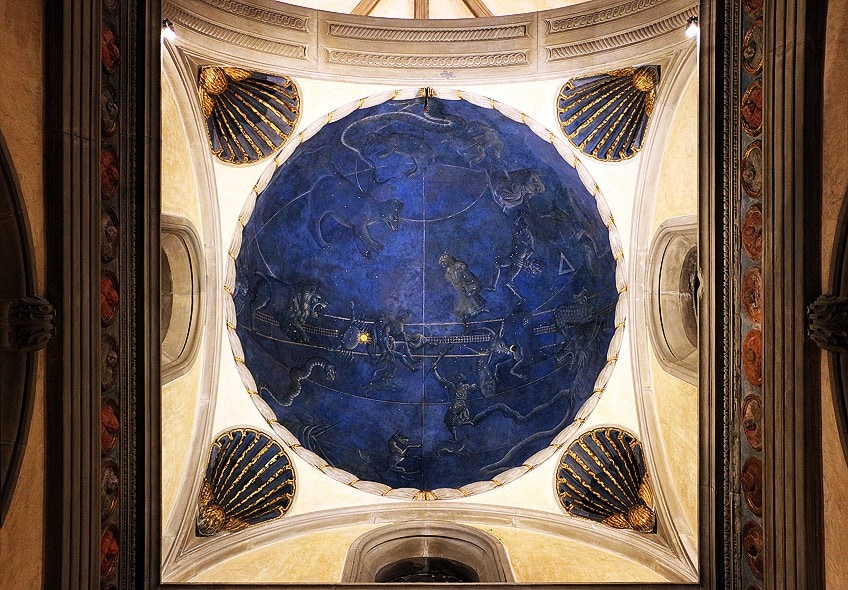 Sky of Florence decoration by Giuliano d'Arrigo on the small dome in the Old Sacristy (1442);Sailko, CC BY 3.0, via Wikimedia Commons
Sky of Florence decoration by Giuliano d'Arrigo on the small dome in the Old Sacristy (1442);Sailko, CC BY 3.0, via Wikimedia Commons
Because the guild had already allowed him – and numerous other artists – permission to operate as an architect sans paying the due amount, his arrest was most likely orchestrated by his anti-Medici opponents, who had previously pushed his benefactor Cosimo de' Medici into banishment the previous year. Brunelleschi, on the other hand, was released after less than a week. Ultimately, the dome of Santa Maria del Fiore was completed enough for the chapel to be sanctified in March 1436, even though its exterior areas were not completely finished and the layout for the cupola that would head the arrangement had not yet been decided.
Brunelleschi, of course, had a strategy, but despite having accepted his imaginative concept for the dome, the cathedral's governing council held another competition for the cupola.
Lorenzo Ghiberti offered a rival design, but Brunelleschi won out, and by the end of the year, his wooden prototype of the cupola was chosen as the winning entry. Construction on the church of Santo Spirito, which Brunelleschi had been hired to substitute for the previous Augustinian monastery church on the site, also started about this time.
This was an occasion to construct an entire complex instead of a piece of an already complicated structure, and it expresses Brunelleschi's worldview probably more thoroughly than many of his earlier works. In line with his plans, he had started a church with Santo Spirito.
Because the project was funded by a group of wealthy parishioners rather than a single patron like Medici, architectural historian Howard Saalman believes the design conveys the Florentine aesthetic of a society of unity, with its primarily central plan framework integrating 40 identical chapels.
Even though much of the job on the church was done after the architect's death – in fact, the first massive column of the tower showed up on-site only a week before he actually died – Brunelleschi's architecture, which was most likely based on simple geometric and proportional concepts that successive constructors could easily implement, was largely followed until its finalization in the 1480s. Brunelleschi also worked on a proposal for an oratory for the church of Santa Maria degli Angeli in the 1430s.
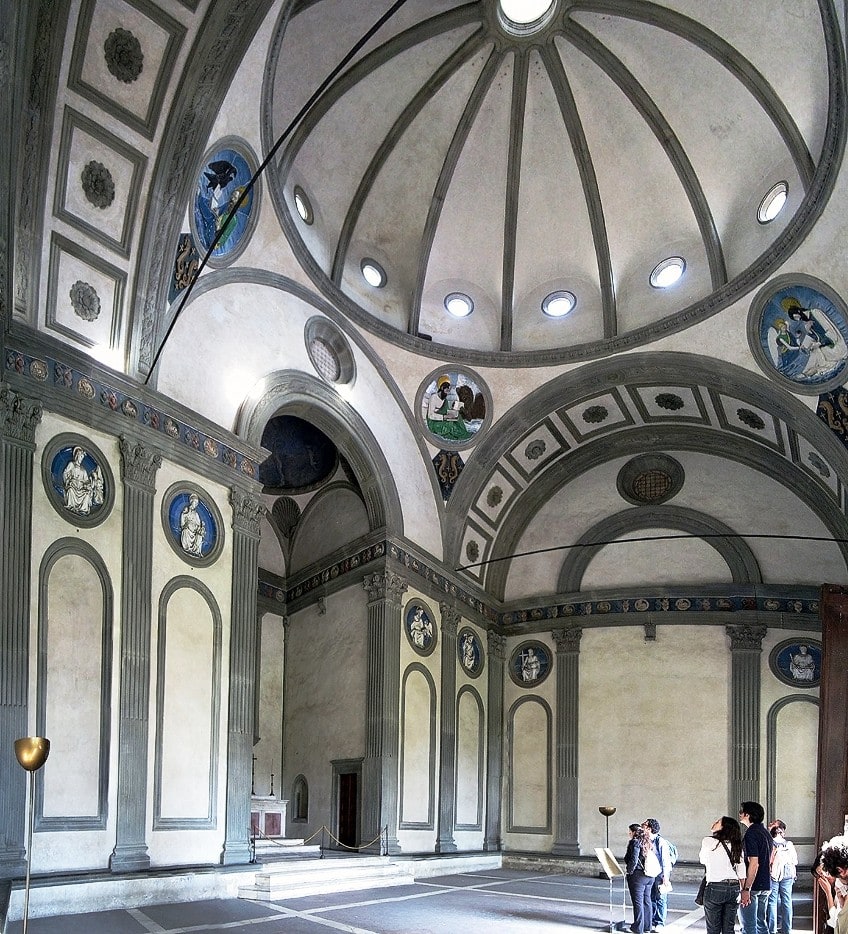 Interior of the Pazzi Chapel in Florence; Gryffindor, CC BY-SA 3.0, via Wikimedia Commons
Interior of the Pazzi Chapel in Florence; Gryffindor, CC BY-SA 3.0, via Wikimedia Commons
The small building was to be focused on an octagonal inner surface, a creative, beautifully centralized scheme that was undoubtedly motivated by late medieval central buildings like segments of the cathedral and Baptistery of Florence, as well as Roman structures like the Pantheon. Work began in 1434 and lasted three years, but when Florence was embroiled in another battle with a neighboring city in 1437, the Scolari money ran out, and the construction was abandoned. The project remained incomplete until the 20th century when the Brunelleschian components were altered and the structure was completed in a new style.
Several illustrations of Brunelleschi's layout, the most significant of which was made before 1494 by designer Giuliano da Sangallo and was likely predicated on a questionnaire of the incomplete facility, and the other by Leonardo da Vinci in his notebook, along with subsequent duplicates, are the only proof of his original aspirations.
In the late 1430s and early 1440s, Brunelleschi was involved in several continuing projects, including supervising the slowly growing lantern of Santa Maria del Fiore, planning military construction, and creating stage gear for religious performances. He also witnessed the start of construction on the Pazzi chapel, which was designed as a lodge for the brothers of Santa Croce monastery.
Although there is limited evidence and scholars vary on Brunelleschi's role, Saalman believes he drew up ideas for the edifice around 1429, the year Giovanni de' Medici died, because the chapel's design is similar to that of the San Lorenzo sacristy built by Brunelleschi.
Late Period and Death
Brunelleschi remained working on various projects in his last years while declaring to be too elderly to profit from his labor – most likely to avoid paying further taxes. Manetti, his biographer, adds that he was contracted to design several residential structures, but there is no documented evidence to back this up, and researchers continue to argue his role in specific projects. One building he actually worked on was a big modern area, the Sala Nuova, in the villa of the Guelph Group – a politically powerful collective in Florence and other north and central Italian towns – though the facility has since been changed, making it complicated to ascertain how much of what endures can be attributed to Brunelleschi.
The Party had purchased land and began construction in 1300, constructing facilities that were renovated throughout time, and had planned an extension of their headquarters in 1415. Brunelleschi's participation likely started after 1442, and one of his main priorities was to build a framework within the congested limits of a city block between many small roads that would be as clear as feasible to bystanders who traversed Florence's core bridge, the Ponte Vecchio, due only to its magnitude and size.
This issue was characteristic of the designer's focus on the urban environments around the structures he created, and it converted the Guelph Party palace from a regular bureaucratic edifice to an important monument of Renaissance architecture.
 Detail of the classical pilasters of the Sacristy; I, Sailko, CC BY-SA 3.0, via Wikimedia Commons
Detail of the classical pilasters of the Sacristy; I, Sailko, CC BY-SA 3.0, via Wikimedia Commons
Due to recurrent wartime wars and the difficulty in obtaining the white marble that was to cover the cathedral's façade, the lantern was still under construction throughout these years. The materials started to show up on the site in 1443, and to move the gigantic stones into position, Brunelleschi constructed new hoists and other devices that could work at the top of the structure without being dependent on ground support.
When he died, a funeral service was performed in Santa Maria del Fiore under the dome he had built himself, which was accompanied by thousands of mourners. A death mask was made from his features, a unique honor, and after roughly a month of deliberation, it was decided that he should be placed in the cathedral itself, instead of in his family vault in another church.
His tomb, nevertheless, was humble, and its position was only rediscovered in 1972, when a simple marble slab with the epitaph "Here rests the great inventive man Filippo Brunelleschi of Florence" was unearthed, implying that he was recognized for his brilliance as an architect as well as his creative thinking as a designer.
Legacy and Accomplishments of Filippo Brunelleschi
Brunelleschi was a trailblazer in several domains, including architecture, engineering, city planning, and representation systems. He was discreet about his techniques since he was more concerned with his capacity to make a living from his inventiveness than with future acclaim, therefore direct recording of production is limited, however significant information may be gleaned from government documents and other contemporary sources.
Nevertheless, his name was firmly cemented during his lifetime due to the structures he produced, notably the dome of Santa Maria del Fiore church.
Legacy
That he was the topic of the first full-length biography of an architect since the ancient era is one indication of his significance. His creativity and achievement also contributed to the profession of architecture gaining new importance, as practitioners grew to be seen as artists rather than physical laborers. Donatello, his direct pupil, became principally a sculptor, as did Buggiano, his adoptive son, with whom he also collaborated.
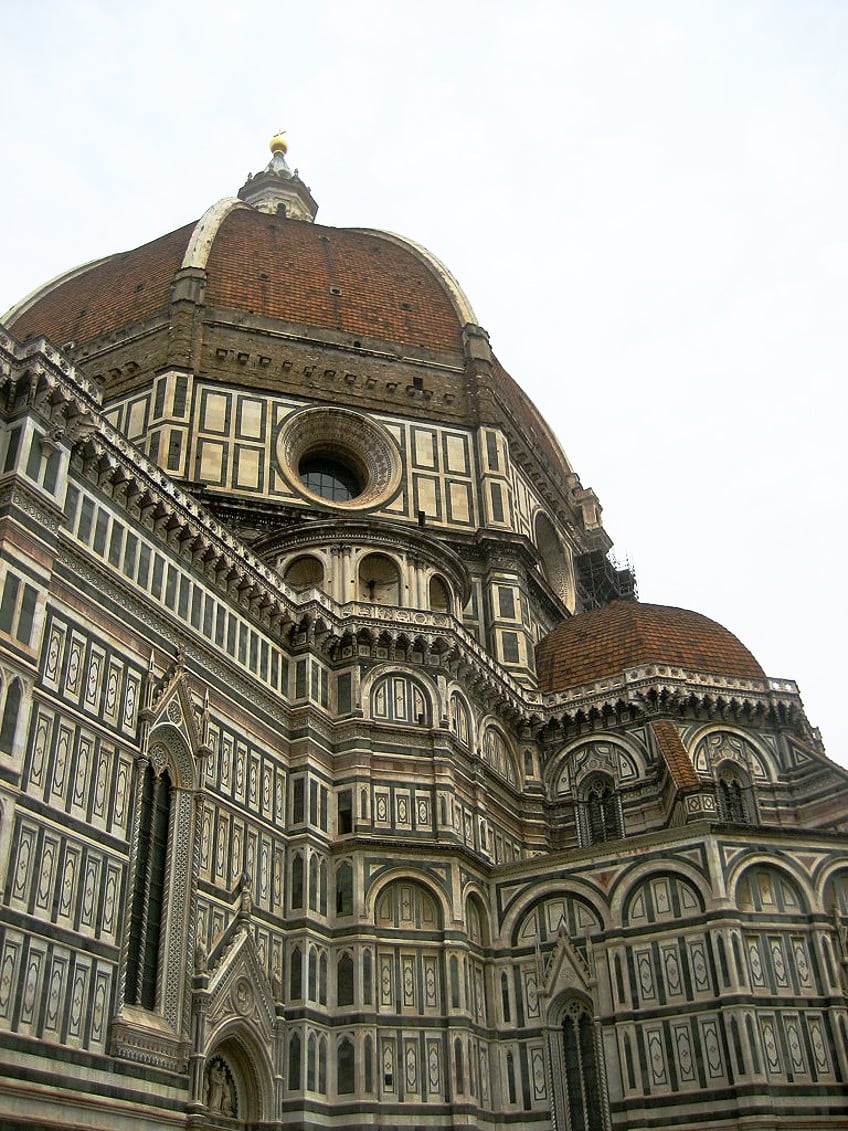 The Florence Cathedral dome (1420 – 1461), viewed from below;DearEdward from New York, NY, USA, CC BY 2.0, via Wikimedia Commons
The Florence Cathedral dome (1420 – 1461), viewed from below;DearEdward from New York, NY, USA, CC BY 2.0, via Wikimedia Commons
Many others, however, lauded, researched, and were inspired by Brunelleschi's architecture and engineering endeavors, such as Leon Battista Alberti, who devoted his painting manuscript to the designer and printed the technique of linear perspective which Brunelleschi had invented. Michelozzo di Bartolomeo also imitated his aesthetic in trying to take over many of his construction projects after his passing.
Finally, Leonardo da Vinci went on to write down many notes on Filippo Brunelleschi's artwork in his notebooks. Architects of future generations borrowed directly from Brunelleschi's streamlined, strong style.
Accomplishments
Brunelleschi's overarching strategy for architectural design was to develop logical buildings based on recurring modules using simple geometric concepts. His layouts and elevations were often composed of repetitive and divided circles and squares integrated logically to create balanced beautiful buildings.
Brunelleschi incorporated the processes of proportions and functional and architectural elements he discovered in ancient Roman building structures that had been overlooked for hundreds of years – such as capitals, columns, arches, and vaults – into his construction methods, helping to build the prevalent Renaissance architecture style.
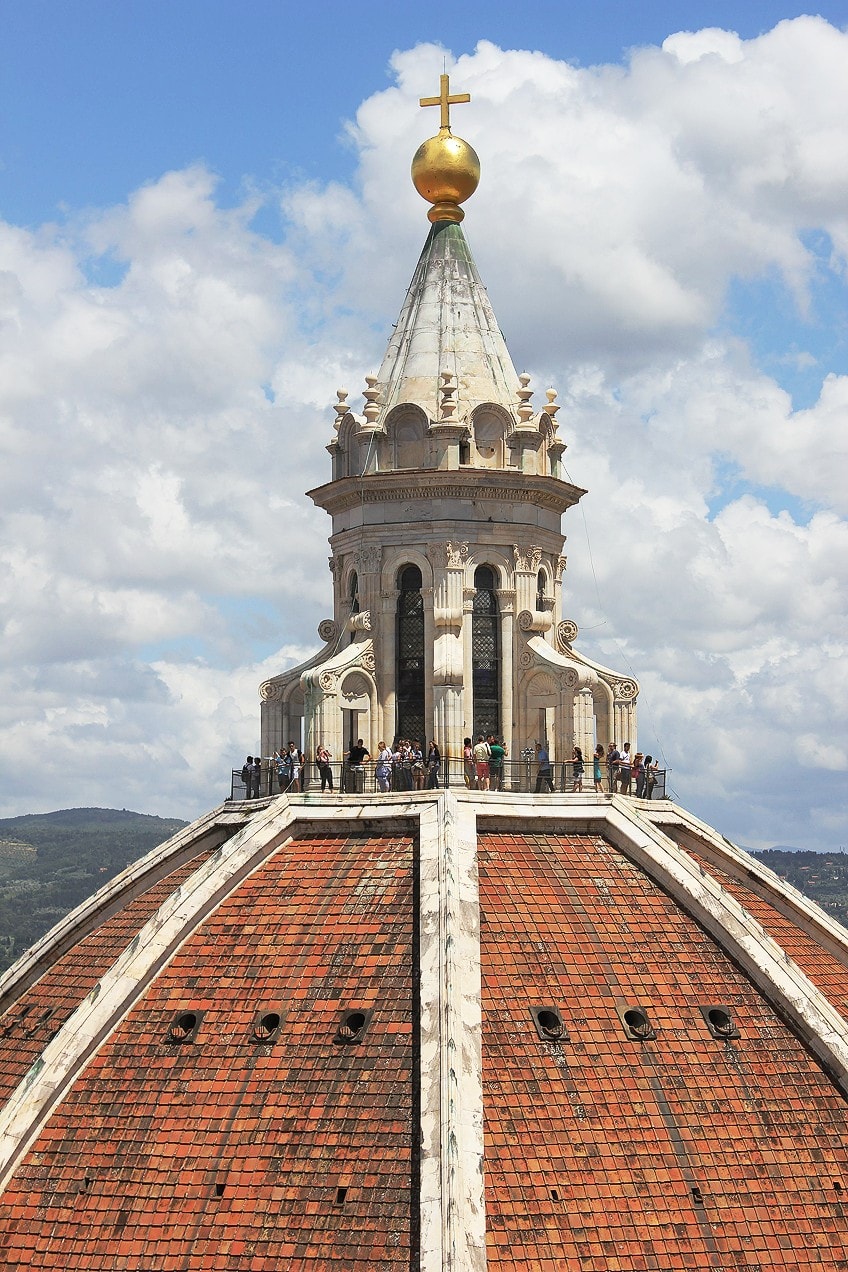 The lantern of the Florence Cathedral dome (1420 – 1461), viewed from the top of Giotto's bell tower; birasuegi from Errenteria, Basque Country, CC BY-SA 2.0, via Wikimedia Commons
The lantern of the Florence Cathedral dome (1420 – 1461), viewed from the top of Giotto's bell tower; birasuegi from Errenteria, Basque Country, CC BY-SA 2.0, via Wikimedia Commons
Filippo Brunelleschi's Most Important Works
Brunelleschi utilized innovative technical concepts to produce tools and machinery that aided construction and helped in other fields like military fortifications and theatrical stage procedures, in addition to erecting structures.
In his structures, he stressed structural features above adornment, frequently defining the framework in gray stone to juxtapose with light-colored walls. Below are a few of his most important works.
- Old Sacristy of San Lorenzo (1428)
- Dome of the Cathedral of Santa Maria del Fiore (1436)
- Oratory of Santa Maria degli Angeli (1437)
- Foundling Hospital (1445)
- Pazzi Chapel (1478)
- Basilica of Santo Spirito (1482)
Recommended Reading
In this article, we learned about the life and architecture of Filippo Brunelleschi. However, you might want to discover more about his life in your own time. Simply check out our list of recommended books to find out even more about the architect's life and career.
F ilippo Brunelleschi (2002) by Eugenio Battisti
Eugenio Battisti, one of the world's foremost specialists in the development of Italian architecture, discusses Brunelleschi's accomplishments here. Brunelleschi studied the aspects and procedures of traditional Roman architecture with zeal, which led him to devise a sensible way to measure spaces and pursue an architecture in which each part is in perfect harmony and proportioned to the whole, along with the creation of viewpoint. This rationality is the bedrock of his discourse, and it pervades Florence's whole urban structure.

- Formally presents the work of Brunelleschi
- Written from a purely architectural perspective
- Written by a leading expert on the history of Italian architecture
View on Amazon
Brunelleschi: Studies of His Technology and Inventions (2004) by Frank Prager
Filippo Brunelleschi, a forerunner of Italian Renaissance architecture, is most known for his bold and unique designs, including the beautiful dome of Florence's iconic church, Santa Maria del Fiore. Brunelleschi built a massive dome without an underlying framework for the construction, which began in 1420 and was significantly finished by 1434. The building took place throughout his life and became the foundation of Italian architecture at the time.

- Of value to students of architecture and engineering
- Complemented by 28 photographs and 18 line illustrations
- Comprehensive narrative about the artist's many achievements
View on Amazon
With that, we conclude our look at the life and Renaissance architecture of Filippo Brunelleschi. Filippo Brunelleschi's paintings were also respected, but it was Brunelleschi's architecture that left a permanent mark on Italian society. His building of a dome for Florence's famed cathedral, labor that had gone unfinished for a century, earned him enormous recognition during his career and remains his most recognized effort.
Frequently Asked Questions
Why Is Filippo Brunelleschi's Artwork Important?
Filippo Brunelleschi's artwork was famous for displaying the artist's greatest achievement: the invention of the linear perspective technique for showing a three-dimensional scene. The realistic technique used in Filippo Brunelleschi's paintings quickly became the dominant method of portrayal in European art till the present day. The Filippo Brunelleschi biography book was the first biography to be written about an artist since classical times.
What Defined Brunelleschi's Architecture?
Brunelleschi prioritized structural shapes above adornment in his structures, frequently defining the framework in dark gray stone to contrast with light-colored plaster walls. His designs often had minimal ornamental embellishments, instead of relying on basic, forceful form pairings for esthetic effect. Brunelleschi not only built structures but also devised creative engineering concepts for equipment and machinery that aided construction and helped in other fields like military fortifications and dramatic stage operations.
gallionlostactunce95.blogspot.com
Source: https://artincontext.org/filippo-brunelleschi/
0 Response to "Was Brunelleschi Easy to Get Along With"
Postar um comentário